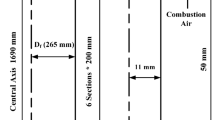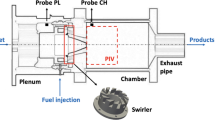Abstract
The present work focuses on the numerical simulation of diffusive flames in a confined high-swirl burner. Navier–Stokes equations expressed for a time-dependent, compressible, and three-dimensional flow with finite-rate kinetics are solved for lean methane/air mixtures. A simplified mechanism is used to model the combustion. Non-reactive and reactive cases are contrasted for a swirl number of 0.95. Three flames for swirl numbers of 0, 0.6, and 0.95 are analyzed. In swirling flows, the inner recirculation zone is mainly composed of reaction products, which help in ignition of the incoming fuel. Moreover, the forward stagnation point plays an important role, leading to an azimuthal deflection of the flame front.
Similar content being viewed by others
References
S. Ishizuka, “Flame Propagation along a Vortex Axis,” Prog. Energy Combust. Sci. 28, 477–542 (2002).
J. Chomiak, A. Gorczakowski, T. Parra, and J. Jarosinski, “Flame Kernel Growth in a Rotating Gas,” Combust. Sci. Technol. 180 (2), 391–399 (2008); DOI: 10.1080/00102200701740964.
P. L. Therkelsen, J. E. Portillo, D. Littlejohn, S. M. Martin, and R. K. Cheng, “Self-Induced Unstable Behaviors of CH4 and H2/CH4 Flames in a Model Combustor with Low-Swirl Injector,” Combust. Flame 160, 307–321 (2013).
D. A. Rotman and A. K. Oppenheim, “Aerothermodynamic Properties of Stretched Flames in Enclosures,” in Twenty-First Symp. on Combustion, 1986, pp. 1303–1312.
D. Dunn-Rankin, P. K. Barr, and R. F. Sawyer, “Numerical and Experimental Study of “Tulip” Flame Formation in a Closed Vessel,” in Twenty-First Symp. on Combustion, 1986, pp. 1291–1301.
A. Valera-Medina, N. Syred, and A. Griffiths, “Visualisation of Isothermal Large Coherent Structures in a Swirl Burner,” Combust. Flame 156, 1723–1734 (2009); DOI: 10.1016/j.combustflame.2009.06.014.
A. Olivani, G. Solero, F. Cozzi, and A. Coghe, “Near Field Flow Structure of Isothermal Swirling Flows and Reacting Non-Premixed Swirling Flames,” Experim. Therm. Fluid Sci. 31, 427–436 (2007); DOI: 10.1016/j.expthermflusci.2006.05.003.
N. Syred, A. Giles, J. Lewis, M. Abdulsada, A. Valera Medina, R. Marsh, P. J. Bowen, and A. J. Griffiths, “Effect of Inlet and Outlet Configurations on Blow-Off and Flashback with Premixed Combustion for Methane and a High Hydrogen Content Fuel in a Generic Swirl Burner,” Appl. Energy 116, 288–296 (2014); DOI: 10.1016/j.apenergy.2013.11.071.
K. Khanafer and S. M. Aithal, “Fluid-Dynamic and NOx Computation in Swirl Burners,” Int. J. Heat Mass Transfer 54, 5030–5038 (2011); DOI: 10.1016/j.ijheatmasstransfer.2011.07.017.
R. Roback and B. V. Johnson, “Mass and Momentum Turbulent Transport Experiments with Confined Swirling Coaxial Jets,” NASA CR-168252 (1983).
M. T. Parra-Santos, F. Castro-Ruiz, and C. Mendez-Bueno, “Numerical Simulation of the Deflagration to Detonation Transition,” Fiz. Goreniya Vzryva 41 (2), 108–115 (2005)
M. T. Parra-Santos, F. Castro-Ruiz, and C. Mendez-Bueno, Combust., Expl., Shock Waves 41 (2), 215–222 (2005).
R. G. Schmitt, P. B. Butler, and N. French, “Chemkin Real Gas: A Fortran Package for the Analysis of Thermodynamics and Chemical Kinetics in High Pressure Systems,” Univ. Iowa Rep. No. UIME-PBB 93-006 (1993).
P. M. Congedo, C. Dupra, G. Balarac, and C. Corre, “Numerical Prediction of Turbulent Flows using Reynolds-Averaged Navier–Stokes and Large-Eddy Simulation with Uncertain Inflow Conditions,” Int. J. Numer. Methods Fluids 72, 341–358 (2013); DOI: 10.1002/fld.3743.
K. K. J. Ranga Dinesh, M. P. Kirkpatrick, and K. W. Jenkins, “Investigation of the Influence of Swirl on a Confined Coannular Swirl Jet,” Computers Fluids 39, 756–767 (2010).
Author information
Authors and Affiliations
Corresponding author
Additional information
Original Russian Text © M.T. Parra-Santos, V. Mendoza-Garcia, R. Szasz, A.N. Gutkowski, and F. Castro-Ruiz.
Published in Fizika Goreniya i Vzryva, Vol. 51, No. 4, pp. 29–36, July–August, 2015.
Rights and permissions
About this article
Cite this article
Parra-Santos, M.T., Mendoza-Garcia, V., Szasz, R. et al. Influence of flow swirling on the aerothermodynamic behaviour of flames. Combust Explos Shock Waves 51, 424–430 (2015). https://doi.org/10.1134/S0010508215040048
Received:
Published:
Issue Date:
DOI: https://doi.org/10.1134/S0010508215040048




